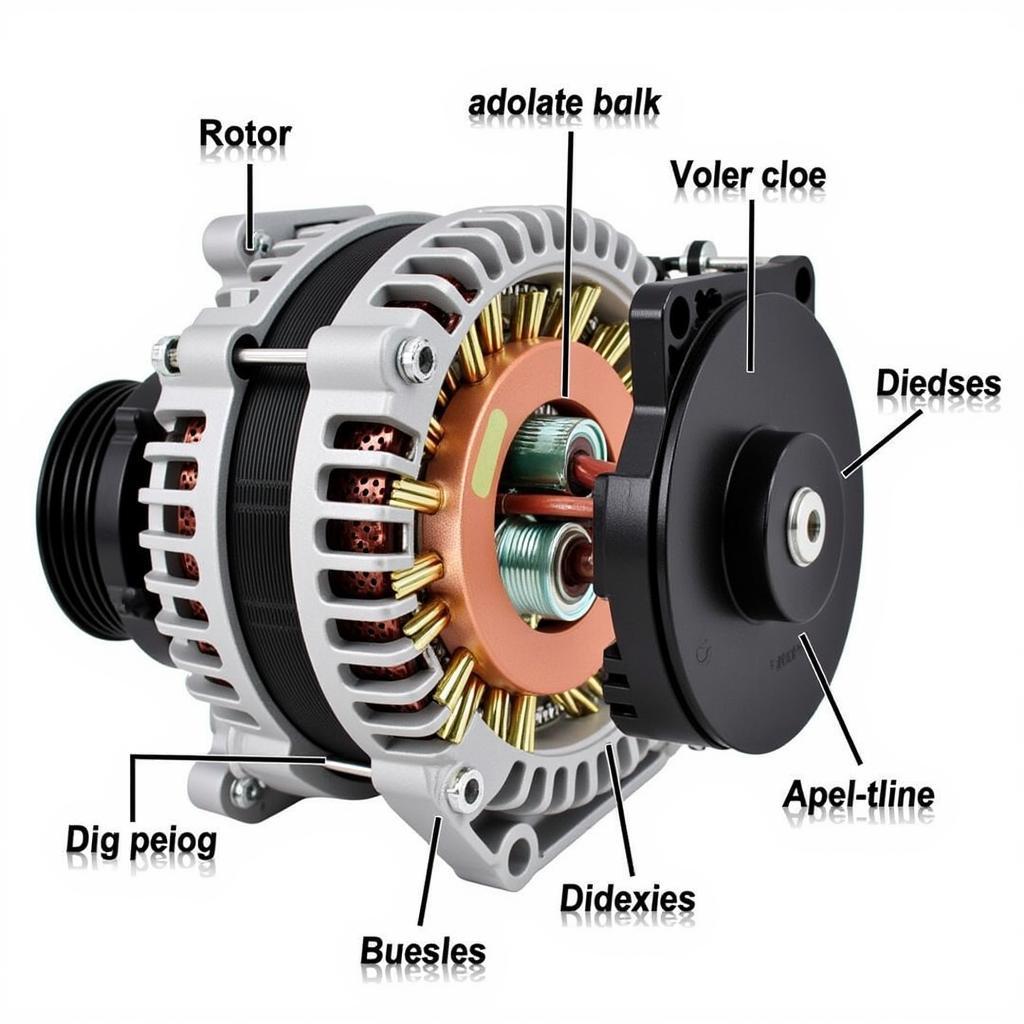Alternator In Cars Problem is a common issue that can leave you stranded. Understanding the alternator’s function, recognizing the signs of failure, and knowing how to troubleshoot and fix the problem can save you time and money. This guide provides a comprehensive overview of alternator problems, from diagnosis to solutions.
Having a reliable alternator is crucial for any vehicle. It’s the heart of your car’s electrical system, charging the battery and powering all electrical components. If you’re experiencing electrical issues or your car won’t start, the alternator might be the culprit. Learn more about common car starting problems at common car not starting problems.
Understanding the Alternator’s Role
The alternator is essentially an AC generator that converts mechanical energy from the engine into electrical energy. This energy is then used to charge the battery and power everything from the headlights to the radio. Without a functioning alternator, your car’s battery will quickly drain, leading to a complete electrical failure.
Why is My Alternator Failing?
Several factors can contribute to alternator failure. These include worn-out brushes, damaged diodes, a failing voltage regulator, or even a loose or broken drive belt. Over time, these components can wear down or become damaged, leading to a decrease in performance or complete failure. You might want to check for other electrical issues as well, learn more at diy car electrical problems.
 Alternator Internal Components Diagram
Alternator Internal Components Diagram
Recognizing the Signs of an Alternator Problem
Dimming headlights are a classic sign of alternator trouble. Other symptoms include flickering interior lights, a whining or grinding noise coming from the engine compartment, a battery warning light on the dashboard, or difficulty starting the car. If you notice any of these signs, it’s important to have your alternator checked as soon as possible.
How Can I Test My Alternator?
There are a few simple ways to test your alternator. You can use a multimeter to check the battery voltage with the engine off and then again with the engine running. A significant drop in voltage indicates a problem. You can also take your car to a mechanic for a more thorough diagnostic test.
Troubleshooting and Fixing Alternator Issues
If you’re mechanically inclined, you can troubleshoot and even fix some alternator problems yourself. Start by checking the drive belt for any signs of wear or damage. If the belt is loose or broken, it needs to be replaced. Next, inspect the alternator’s wiring and connections for any loose or corroded terminals. Cleaning or tightening these connections might resolve the issue. However, if the problem lies within the alternator itself, such as worn-out brushes or a faulty voltage regulator, it’s best to have the alternator replaced or rebuilt by a qualified mechanic. Sometimes, problems can arise even after towing. Read more about that here: problems with car after being towed.
What are the Costs Involved in Alternator Repair or Replacement?
The cost of alternator repair or replacement varies depending on the make and model of your car and the labor rates in your area. A new alternator can cost anywhere from $150 to $500, while labor costs can range from $100 to $300. Rebuilding an alternator is often a more affordable option, costing around $50 to $150. If you’re considering renting a car due to alternator issues, be aware of potential rental car issues: car rental companies problems.
“A failing alternator is not something to ignore,” says automotive expert John Smith, ASE Certified Master Technician. “Ignoring the problem can lead to a dead battery, leaving you stranded and potentially causing further damage to other electrical components.”
Preventing Future Alternator Problems
Regular maintenance is key to preventing alternator problems. Ensure that your car’s battery is in good condition and that the terminals are clean and tight. Have your alternator inspected by a mechanic during routine maintenance checks. This proactive approach can help identify potential problems before they escalate.
“Regularly inspecting the drive belt and ensuring proper tension can significantly extend the life of your alternator,” adds Jane Doe, lead mechanic at Smith’s Auto Repair. “This simple check can prevent premature wear and tear on the alternator’s internal components.”
Conclusion
Alternator in cars problem can range from minor inconveniences to major breakdowns. Understanding the signs of a failing alternator, knowing how to troubleshoot the issue, and taking preventative measures can keep your car running smoothly. If you suspect an alternator problem, don’t hesitate to seek professional help. For personalized support and assistance, please contact AutoTipPro at +1 (641) 206-8880 or visit our office at 500 N St Mary’s St, San Antonio, TX 78205, United States.
FAQ
-
How long does an alternator typically last?
An alternator can last anywhere from 4 to 8 years, depending on usage and maintenance. -
Can I drive my car with a bad alternator?
You can drive a short distance with a bad alternator, but the battery will eventually drain, leaving you stranded. -
What is the difference between an alternator and a starter?
The starter cranks the engine to start it, while the alternator generates electricity to power the car’s electrical system and charge the battery. -
How can I tell if my battery is bad or my alternator is bad?
If your car starts but then dies shortly after, the problem is likely the alternator. If the car doesn’t start at all, the battery is likely the culprit. -
Can a bad alternator damage my car’s computer?
While rare, a failing alternator can send voltage spikes through the electrical system, potentially damaging sensitive electronics like the car’s computer. More car problems and reviews can be found at car review and problems. -
What causes an alternator to overcharge?
A faulty voltage regulator is the most common cause of alternator overcharging. -
How often should I have my alternator tested?
It’s recommended to have your alternator inspected during routine maintenance checks, typically every 30,000 miles or so.







Leave a Reply